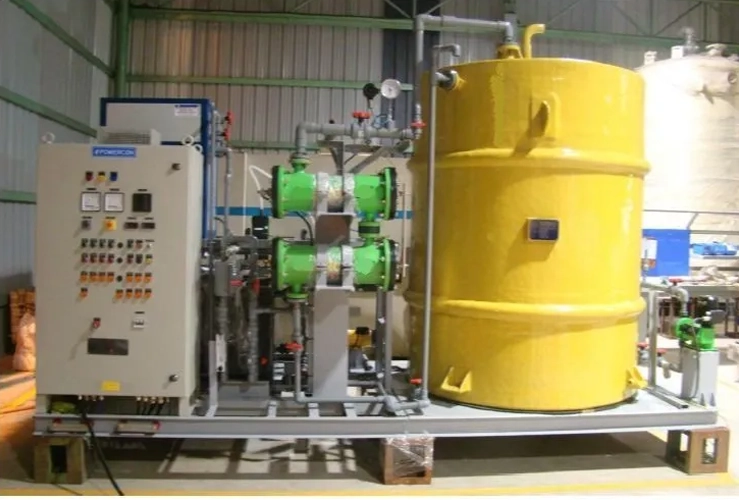Electro Chlorinator (for online Sodium Hypochlorite (NaOCl) generation)
An electro-chlorinator, also known as an electrolytic chlorination system or an electrochlorination system, is a device use in wastewater treatment to generate chlorine on-site through the process of electrolysis. Chlorination is a common method used for disinfection and oxidation in wastewater treatment to eliminate pathogens and control odor.
System Components
Electrolytic Cell: The heart of the electro-chlorinator is the electrolytic cell, where the electrolysis process occurs. The cell typically consists of an anode and a cathode separate by a membrane or diaphragm. The anode is typically made of a material such as titanium coate with a mixed metal oxide (MMO), while the cathode is usually made of stainless steel.
Brine Solution: A brine solution, usually sodium chloride (NaCl) dissolved in water, is supplied to the electrolytic cell as the source of chlorine. The brine solution flows over the anode, and when an electric current is applie, it undergoes electrolysis.
Power Supply: The electro-chlorinator requires a power supply to provide the electric current necessary for the electrolysis process. The power supply is typically a rectifier that converts alternating current (AC) to direct current (DC) at the appropriate voltage and current levels.
Control System: An electro-chlorinator is equippe with a control system to regulate and monitor the chlorine production process. The control system allows for adjusting the chlorine output base on the wastewater flow rate and disinfection requirements.
Process Description
Electrolysis: The brine solution is pumpe into the electrolytic cell, and an electric current is applied. As a result, chloride ions (Cl-) from the brine migrate to the anode, where they undergo oxidation, producing chlorine gas (Cl2).
Chlorine Dissolution: The chlorine gas generate at the anode dissolves in the water, forming hypochlorous acid (HOCl) and hypochlorite ions (OCl-). These are the active disinfecting species that provide the desire disinfection and oxidation effects in the wastewater.
Discharge and Application: The chlorine-containing solution is then introduce into the wastewater flow, typically through injection points or by blending with the wastewater stream. The chlorine disinfects the wastewater by destroying bacteria, viruses, and other microorganisms, as well as controlling odor-causing compounds and reducing organic matter.
Significance & Advantages
On-Site Chlorine Generation: Electro-chlorinators produce chlorine on-site, eliminating for transportation, handling, and storage of chlorine gas or liquid chlorine. This enhances safety and reduces the risks associate with chlorine handling.
Control and Flexibility: The chlorine output of electro-chlorinators can be easily adjust to meet the specific disinfection requirements of the wastewater treatment process. The control system allows for precise dosing and monitoring of chlorine levels.
Environmental Friendliness: Electro-chlorination does not produce harmful byproducts, such as chlorinate organic compounds, as can occur with some other chlorination methods.
Electro-chlorinators find applications in various wastewater treatment processes, including municipal wastewater treatment plants, industrial wastewater treatment, and water reclamation facilities. They provide an efficient and cost-effective means of chlorine generation for disinfection and oxidation purposes in wastewater treatment.
Targeted Impurities
- Pathogens
- Odor





